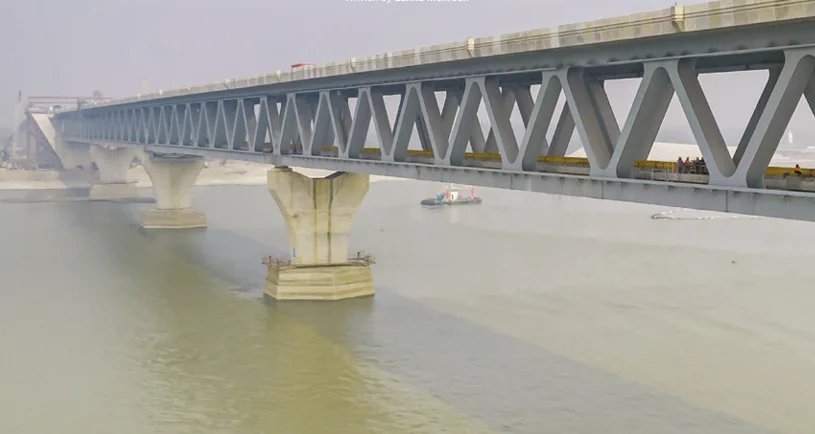

The opening of the Padma Bridge has created the scope for a new wave of investment in the country’s south and south-western region. The region’s easier road communications with the rest of the country has brought fresh momentum for business growth. New industries are being planned and tourism sector entrepreneurs are hoping for a business boom surrounding Kuakata sea beach and the Sundarbans. Thus, the bridge has offered a new economic corridor in the making. Economists and business leaders believe with remarkable improvement in road network though the bridge trade and business in the region would expand rapidly, raising the people’s income, creating jobs and eradicating poverty. The Padma Bridge is also expected to bring about a massive change in the entire economy. The Ministry of Road Transport and Bridges believes the economic corridor surrounding the Padma Bridge and its adjacent areas would increase the country’s GDP (gross domestic product) growth by 1.27 percentage point. The southern region’s economy will grow at a higher pace. Predicting a higher GDP growth for the Padma Bridge, the Asian Development Bank (ADB) said the rate of poverty reduction will be accelerated by 0.84 per cent every year. However, as many as 53 upazilas out of 133 upazilas in 21 districts on the south-western side of the bridge are of high concentration of poverty, according to Bangladesh Bureau of Statistics (BBS) poverty map. Another 42 upazilas are in the medium poverty risk category and 38 in low poverty risk category. Economist and chairman of Palli Karma-Sahayak Foundation (PKSF) Quazi Kholiquzzaman Ahmad said small entrepreneurs are more enthusiastic about the Padma Bridge and they should be provided with opportunity to make investment and various supports such as gas and electricity supply should be ensured at affordable costs. He observed that the bridge has jointed the southern belt with the rest of the country. The bridge will result in smooth transportation of farm produces from the region, according to Implementation, Monitoring and Evaluation Division (IMED) of the Ministry of Planning. It said farmers’ income will increase 15-20 per cent since direct connections between farmers and the market forces will be established. Transport sector insiders added the time for transportation of goods from Benapole to Dhaka would come down to 6-7 hours from 24-36 hours. The southern region was attractive for low-cost transport of goods by river routes but longer time and uncertainity in ferry services earlier discouraged the entrepreneurs from taking business initiatives. The Padma Bridge has now created the scope for big companies to come forward with investment projects in the region. The companies that have shown interest in setting up factories in the region include Sheltech, Pran-RFL, TK Group, Envoy Group, Hameem Group, Mir Group, Karim Group and Opsonin Pharma. Bangladesh Economic Zones Authority (BEZA) has unveiled a master plan on Padma Bridge that would directly benefit Dhaka, Khulna and Barisal divisions. It is taking steps to establish 17 new Economic Zones (EZ) in 21 districts of the three divisions. In the 1960s, Khulna became one of the few industrial hubs of the country but it has subsequently lost the glory. However, after the launch of Padma Bridge, Khulna is drawing attention of the investors. Abdus Salam Murshedi MP, president of Bangladesh Exporters’ Association (BEA) and former president of BGMEA said, “I definitely want to use this opportunity. I want to set up a new garment factory in Khulna. I also encourage others to invest in the region.” In fact in 2019, Sheltech Group established the country’s largest ceramics industry in the southern district of Bhola. The company invested more than Tk 7 billion taking advantage of local natural gas and cheap land with the hope of opening of the Padma Bridge in 2022. Now, Sheltech is also planning to set up a non-denim garment factory in Bhola, said Engineer Kutubuddin Ahmed, chairman of the group. “We are now looking for land to set up a ready-made garment industry in Barisal. After the inauguration of the Padma Bridge, investing in the south is the most promising one,” he added. Chini Tikri The Inaugural Murals By 15,000 Ceramic Plates One of the two spectacular installations at each end of the Padma Bridge is its inaugural mural – which has been constructed by using 15,000 ceramic plates. The portraits of Father of the Nation Bangabandhu Sheikh Mujibur Rahman and Prime Minister Sheikh Hasina have been made by breaking these 37 coloured plates into ‘Chini Tikri’. One was the dreamer of Padma Bridge and the another one is its implementer. As the ceramic plate is broken and made, it starts to sparkle when the sun shines on it. These ceramic plates are hammered and broken into about half a million pieces. Then different colours of the pieces are arranged one after one to create two beautiful portraits. Designed by architect Fazle Karim Shishir of Drishik, the two murals were created by artists Ashraful Alam Riaz and Didar Ul Alam. Both are graduated from the Fine Arts Institute of Dhaka University. The 90-feet-long and 45-feet-high mural at the Mawa end was done by Didar Ul Alam and the 72-feet-long and 36-feet-high mural at the Janzeera end was done by Ashraful Alam Riaz. They told Ceramic Bangladesh that at first the designer thought of making this mural with ceramic tiles, but later they chose ceramic plates of the highest quality considering the bright colour and durability. A total of 15,000 plates of 37 types of colours have been used here. Among them, 7 types of coloured plates are used to display black and white portrait of Bangabandhu. And 30 types of coloured plates are used to produce colourful portrait of Prime Minister Sheikh Hasina. All of these ceramic plates are customised. Because such a variety of colour plates are not usually produced by ceramic companies. Artisan Ceramics made 8,000 plates used in the Mawa end mural and Monno Ceramics made 7,000 plates used in the Janzeera end mural. This construction work was completed in two months by two

An integral part of Dhaka’s image in terms of historical architecture that still remains and has been renovated and preserved is the Ahsan Manzil. And like many of common folks who grew up in Dhaka, they have always wondered, at least once in their lives, the reasons behind why this iconic landmark is painted pink. Perhaps unsurprisingly, Ahsan Manzil’s history is even more colourful. This iconic building was built on a property that has a rich history dating back to the Mughal era at the southern part of Dhaka. During the Mughal Empire, Sheikh Enayet Ullah, Zamindar of the Jalalpur Porgona (Faridpur-Barishal), who was the original owner of the land, built a palace called Rong Mahal (which loosely translates as ‘Colourful Palace’) in 1720 for his amusement, a typical practice amongst wealthy elites at the time. He also had a garden house and a cemetery on this site. After he passed away, his son Sheikh Moti Ullah sold the property to the French traders in Bengal at the time. The new owners soon established a trading house next to the palace. Later, after being defeated in the Palashy War by the British East India Company in 1757, they had to leave their possessions behind. After changing hands a number of times, the property was purchased by Khwaja Alimullah of Begambazar in 1830, who was a prominent merchant and an important figure of Dhaka’s Muslim community at the time. Alimullah renovated the property, turning the trading house into a residence. He also built a mosque and some other important structures in this area. After his death in 1854, his son Khwaja Abdul Ghani inherited the property and named it Ahsan Manzil after his son Khwaja Ahsanullah. He continued renovations; the old building was renamed Ondor Mohol (ladies quarters) and the new building was called Rangmahal (pleasure palace) and was later renamed Ahsan Manzil. Khwaja Abdul Ghani was one of the most influential Nawabs (Zamindar) of Dhaka. Known for his generosity and patronage of arts and culture, he expanded his estate by acquiring more lands around Ahsan Manzil and also played an important role in improving the infrastructure, education, healthcare, trade, and social welfare of Dhaka. In 1859, he built a new building on Ahsan Manzil’s property that resembled European architecture because of its domes and pillars. The Nawab named it Rangmahal and painted it with different colours every year according to his mood. On 7 April 1888, Ahsan Manzil suffered severe damage from a tornado that impacted most of its buildings, except for Rangmahal and it was temporarily abandoned. Khwaja Abdul Ghani then decided to rebuild Ahsan Manzil with more vigour and decorations than previous ones. He hired Martin & Co., a British construction and engineering f irm, who designed Ahsan Manzil with an Indo-Saracenic style, blended with Islamic and European elements. In 1872, the reconstruction work continued under Khwaja Abdul Ghani’s supervision, what was previously the French trading house was rebuilt as a two-storey building similar to the Rangmahal. A wooden bridge connected the first floors of the two buildings. After he died in 1896 at the age of 87 years, his son Khwaja Ahsanullah continued his father’s legacy by taking care of the palace. He added new features like electric lights, gas lamps, and water pumps as part of modernization. The palace was repaired again following the 1897 Assam earthquake. The Nawab family played crucial roles in the modernisation of the Dhaka city, particularly in the development of educational systems, healthcare, and urban infrastructure, including the f iltered water supply system that served the city population. They occupied important positions as Commissioner of Dhaka Municipality. Today, within the hyper-congested and cacophonous urban growth of Old Dhaka, it is difficult to imagine how this majestic edifice once dominated the riverfront skyline of Dhaka. The landmark is a unique fusion of architectural styles, reflecting the rich cultural influences that shaped Bengal it over the centuries. The main palace building showcases a harmonious blend of Mughal and European architectural styles. The Mughal influence is evident in the structure’s domes, arches, and intricate decorative motifs. The ornate design of the palace’s entrance and interior chambers reflects the opulence that was characteristic of the Mughal era. European influences, on the other hand, are seen in the high ceilings, broad staircases, and expansive verandas. The palace’s central ballroom, adorned with crystal chandeliers and European-style furniture and tableware, exudes an air of sophistication that was imported from Europe during the late 19th century. The building faces the Buriganga River and Buckland Dam. On the riverside is a stairway leading up to the 1st floor. A fountain previously sat at the foot of the stairs but was not rebuilt. Along the north and south sides of the building are verandas with open terraces. Ahsan Manzil is ostentatiously European in its architectural expression, even though the building’s recessed verandahs may recall the Mughal treatment of buildings in a tropical climate. Its triple-arched portal, Greco-Roman column capitals, pilasters, and arched windows—all suggest that it is mostly a European-style building, meshed with some decorative Indian motifs. The palace’s soaring dome appears to be more about impressing the viewer on the exterior, rather than within the interior. The dome is at the centre of the palace and is complex in its design. The room at its base is square with brickwork placed around the corners to make it circular. Squinches were added to the roof corners to give the room an octagonal shape and slant gradually to give the dome the appearance of a lotus bud. The dome’s peak is 27.13 metres (89.0 ft) tall. The palace is divided into the eastern side, the Rangmahal, and the western side, the Andarmahal. The Rangmahal features the dome, a drawing room, a card room, a library, a state room, and two guest rooms. The Andarmahal has a ballroom, a storeroom, an assembly room, a chest room, a dining hall, a music room, and a few residential rooms. Both the drawing room and

Bangladesh is at an unprecedented crossroads with power crisis and hyper inflation. At a time when major industries at home suffer an acute power crisis, aggravated by the the Russia-Ukraine war following the Covid-19 pandemic, the recent soft inauguration of the first unit of the 1,320-megawatt Maitree Super-Thermal Power Project, also known as Rampal Power Plant, is believed to have been a relief from the energy crisis. Amid the crisis globally, Bangladeshi stakeholders, especially those involved with the multi billion-dollar export industries, manufacturing sector and the financial sector, are now waiting wholeheartedly for commercial operation of the Rampal Power Plant soon to rid the nation of this power predicament. Domestic energy experts and analysts alongside other stakeholders look optimistic with this project and they are of the opinion that the Rampal power project is economically feasible, sustainable and profitable. Terming it one of the cheapest power plants of its kind in the country, they strongly viewed that the plant will get going with the key objective of generating affordable electricity as a resilient and viable solution to the country’s power crisis. Prime Minister Sheikh Hasina and her Indian counterpart Narendra Modi jointly inaugurated the first unit of the coal-fired super-thermal plant through video conferencing on September 6, 2022. The country’s largest power plant is sited on an area of more than 915 acres of land in Rampal upazilla in south-western Bagerhat district under Khulna division, some 272 kilometres away from the capital Dhaka. The high-efficiency, low-emission supercritical plant site sits 14 kilometres north of the world’s largest mangrove forest, the Sundarbans. About the funders The Rampal power project is a joint venture between India’s state-owned National Thermal Power Corporation (NTPC) Ltd and the state-owned Bangladesh Power Development Board (BPDB). The US$ 2.00 billion joint venture company is known as the Bangladesh-India Friendship Power Company Ltd. (BIFPCL) that builds, runs and operates this power facility. The BIFPCL has been co-promoted by the BPDB of Bangladesh and the NTPC Ltd of India with an equal (50:50) equity investment. According to Bangladesh’s power ministry, the joint venture company will enjoy a 15-year tax holiday. In March 2022, Bangladesh boasted the country’s access to 100 per cent electricity, but the national power grid system failed in July and power outage suddenly began to disturb the nation and the socio-economic activities. The Power Division disclosed that the largest amount of what is technically called load-shedding per day stood at 2,000–2,200 MW during the July-September period. But this shortfall peaked in October, taking it to 2,500–3,000 MW. The start of the project BPDB and NTPC entered into a memorandum of understanding (MoU) instrument in 2010 to implementing this mega power plant project in Bagerhat’s Rampal upazilla that has seen an upturn in economic activities centring this power plant in recent years. An estimated 80 per cent of the project costs will be covered through a long-term loan from the EXIM Bank of India. As the construction of the facility was ongoing, the February 2021 was set as the first deadline for commissioning the power plant’s first unit while the second unit by August 2021, according to competent sources. However, the deadline was extended several times for a number of reasons, including emergence of the Covid-19 pandemic in 2020. Use of coal and technology A coal-fired plant produces electricity by burning coal in a boiler to produce steam. Then the steam, produced under tremendous pressure, flows into a turbine, which spins a generator to create electricity. The steam is then cooled, condensed back into water and returned to the boiler in order to start the process over. Supercritical combustion technology and sophisticated equipment are being used to lessen environmental hazards and thus make this project safe and eco-friendly. Some 6,500 cubic meters of water will be required per hour and minimum 10,000 tonnes of coal will be required to produce 1300 MW electricity every day. The ash content of this imported Indonesian coal is 8-10%. The height of chimney is 275 meters, equivalent to 90 storied building. In its initial stages, there was a strong debate on the red-hot issue of installing this coal-fuelled thermal power facility near a forest and some termed it suicidal with apprehensions of environmental disaster for the forest, which is home to thousands of wild species, flora and fauna. Some environmentalists made a mass call for scrapping of the project. The government, however, showed its determination to go ahead with the project. State energy experts said the project would not be harmful as its supercritical technology will minimise ecological hazards. Eco-warriors demanded that environmental concerns must be given precedence over commercial interest. They called for doing an environmental impact assessment and feasibility study before embarking on the project that may have anthropogenic impacts on environment, including effects on biophysical environments, biodiversity and other resources, let alone emissions of carbon dioxide and other pollutants as well as particulates. The joint venture company has already planted 116,000 different kinds of trees around the project site while the Centre for Environmental and Geographic Information Services (CEGIS) is monitoring the parameters related to the environment of the Rampal site and its adjacent areas, including Khulna and the Sundarbans. Employment opportunities The Rampal power plant project has opened up a job generation opportunity for local people and those affected for construction of this project’s infrastructure and during its operational period. As this region has long remained underdeveloped, opportunity of trade and employment was very limited. The power plant project has come as a relief to some extent. Alongside direct employment in the BIFPCL, there will be a huge opportunity to the locals for business and other indirect employment prospects. Moreover, this industry will usher in economic growth in Rampal in particular and the country in general, creating many downstream and/or related industries. Supply chain The supply chain of coal in all coal-fired power plants, including the Rampal power plant, is the biggest challenge. Technically unique in the plant is the supply chain issue. The Rampal


